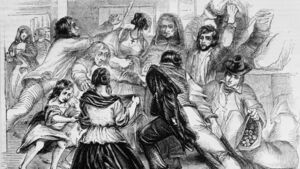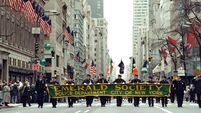The forgotten heroes of the Great Famine in Mayo and Sligo

This sketch depicts starving townspeople raiding a potato store in Galway during the Great Famine. Picture: Hulton Archive/Getty Images
At present, I’m researching and writing a chapter for a book to be published in America this year (2024). The book is the third in a series entitled, . It seeks to identify men and women who can be considered unsung heroes of the Great Irish Famine.
I was invited to contribute 7,000 or so words on my heroes of the Famine because of my two books on that famine: (2021) and (2022). Heroes, not saints, as the people who surfaced during the Great Famine and in retrospect qualify as heroes had their own idiosyncrasies and failings.
After my research on the Great Famine, I had no problem in identifying local heroes in KIllala diocese though I was surprised to discover that, in the main, they were comprised of clergy of the then Established Church or the Church of Ireland, as it became known after its disestablishment in 1871. The reason may be that, when history is written (or is understood) mainly through the prism of denominational bias, we can end up loyally cheer-leading our own side rather than giving credit where credit is due. For good reason, Bishop Thomas McDonnell used to forewarn historians that "to falsify history is an unpardonable sin".
I dedicated , my second book on the Famine, to Rev Francis Kincaid, a curate in Ballina and Rev James Burrows, rector in Castleconnor, both clergy of the Established Church and it can be said without any qualification that both, though their selfless dedication to feeding the hungry of all creeds and none, saved thousands of lives and both lost their own lives by contracting famine fever. Many have been sainted for less.
Kincaid, a native of Dublin, was appointed curate in Ballina in 1837 and died in 1847 at the age of 35. Respected and admired in equal measure by both Catholics and Protestants, Kincaid was an impressive presence in Ballina and its hinterland, through his founding of a loan society in 1838 which organised loans to ‘the poor man’, a category that included all creeds. In 1844, the society dispensed 1,940 loans – which suggests that, with Protestants numbering just 1,400 (or 14 per cent) out of a total population in Ballina parish of 10,000, Catholics benefited overwhelmingly.
When the Famine hit in 1845, Kincaid was in pole position to respond to the human tragedy that was about to unfold and with his friend, Fr Hugh Conway, the Catholic Administrator of the cathedral parish, they decided to set up the Ballina Relief Committee formed with representatives from across the religious divide. An indication of the success of the committee was that the week before Kincaid died, the managers of the soup kitchen informed a meeting of the Relief Committee that each day they were distributing 1,387 quarts of soup to 563 families. And on the day after Kincaid died, the reported that the Committee was distributing 3,427 gallons of soup every day to 1,309 people in Ballina and Ardnaree.
After Kincaid’s death, Conway described him as "decidedly the most charitable, the most benevolent and the most philanthropic man that ever I met". And to mark his death, an inter-church committee, including Kincaid’s friend, Hugh Conway, sought contributions towards a plaque in Kincaid’s memory which was erected in St Michael’s Church, Ardnaree.
James Annesley Burrowes, a native of Longford, came to Killala diocese as private tutor to Bishop Joseph’s children, was appointed rector of Castleconnor and Kilglass in 1804. By 1847, Burrowes and his family were the sole providers of relief in Castleconnor and provided Indian meal for 80 families. Later, they were issuing nearly two tons of meal a week from the rectory in Killanley.
For Burrowes, providing relief derived not just from a religious obligation to feed the hungry but because as part of the Established Church he accepted a civic responsibility not just for his own parishioners but for all citizens.
After years of struggling mightily side by side with his wife, Catherine and their daughters, as much of the actual relief work fell to him and his family, Burrowes died of exhaustion and famine fever in 1849. A daughter, Helen, was also taken by the fever, two years before her father. She was 28. In recording his death, the commented: "Seldom have we had to record the departure of one whose removal will be (more) regretted than that of the vicar of Killanley."
Other clergy of the Established Church whose relief extended beyond their own denomination included Archdeacon George Trulock, rector of Skreen. Trulock was regarded as a friend of the poor and was indefatigable in alleviating their sufferings during the Famine years. Having exhausted himself in his service of the distressed, Catholic and Protestant, he died suddenly in September 1847 from an apoplectic fit. He was aged just 55.
Francis Little, rector of Doonfeeney (Ballycastle), served for 32 years and was friendly with Martin Hart(e), the parish priest of Ballycastle, for 31 years. Little’s wife, Jane, helped out in the soup kitchen in St John’s School in Ballycastle as a result of which she contracted the fever and died on March 20, 1848. Another was Henry Knox, a curate in Moygownagh/Kilfian, who with his wife, Fanny, ran an effective soup kitchen in Fahy, where they were at one point spending £200 from their own resources to feed 200 families as well as an estimated 300 beggars who arrived every day at the family home.
In understanding the context of the time – especially the official effort of the Established Church to convert Catholics to Protestantism, a campaign that was particularly vigorous in Erris and generally caused huge resentment among Catholics – Protestant clergy, in general though not all, made a significant contribution in sustaining the Catholic population in the diocese of Killala during the Great Hunger.
It was not, in the words of famine historian, Donal A. Kerr, "an ecumenical age".





